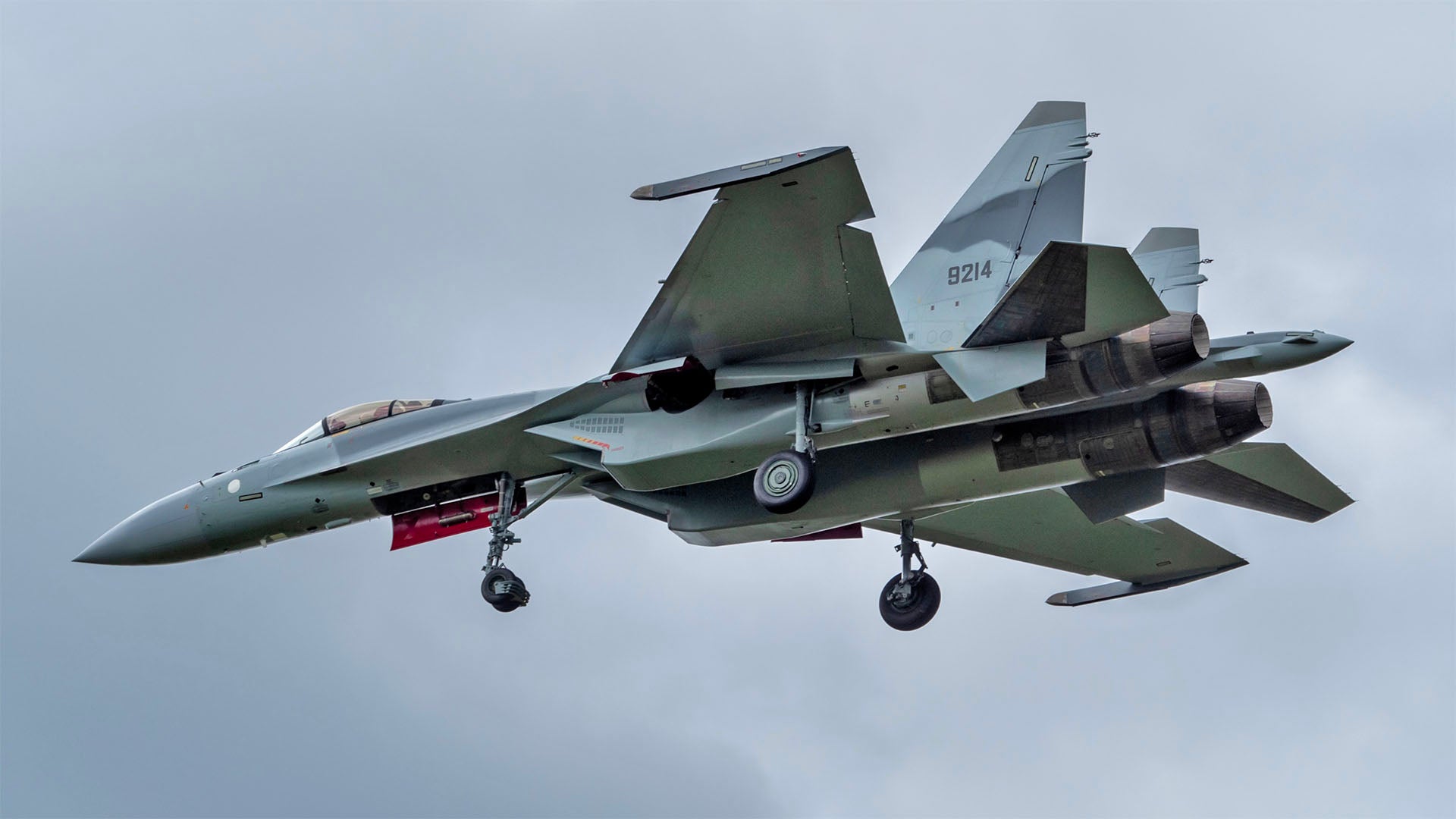The first photos of factory-fresh Egyptian Air Force Sukhoi Su-35SE Flankers have been captured, apparently, as the first batch of jets was on a delivery flight to North Africa. The images of five different “Super Flankers” reveal that the aircraft are painted in the same camouflage scheme as Egypt’s new MiG-29M/M2 Fulcrums.
The photographs were taken by Andrey Neyman on July 22, as five Su-35SE fighters arrived in Novosibirsk for a fuel stop. The location and routing suggest the fighters were on delivery to Egypt from the Komsomolsk-on-Amur Aircraft Plant (KnAAZ) in the Russian Far East. The five different jets carry serials 9210, 9211, 9212, 9213, and 9214. In June, a report by Defence Blog claimed to show satellite images of Egyptian Su-35s at the manufacturing plant.
Although the Su-35 has been tested with external drop tanks, Flankers rarely fly with them, even for long ferry flights. The flight from Komsomolsk-on-Amur to Novosibirsk is well over 2,000 miles, and even though the Flanker boasts an impressive unrefueled range on internal tanks, the aircraft probably required at least one fuel stop between the two locations. It’s also notable that the report from Novosibirsk did not mention transport or in-flight refueling support aircraft.
The Su-35 was conceived as the ultimate variant of the big Russian fighter, sometimes referred to as the “Super Flanker.” It was initially planned for export, however, it is also now in service with the Russian Air Force. The Su-35 features thrust-vectoring engines and a brand-new mission suite, including a Tikhomirov NIIP N135 Irbis Passive Electronically Scanned Array (PESA) radar and a ‘glass’ cockpit.
In May, the Russian state news agency TASS reported that the production of the first five Su-35s for Egypt had begun at KnAAZ. Various other reports have stated that Egypt ordered “over 20” Su-35s, but the exact number varies between 24 and 31 of the new fighters. The deal has never been officially confirmed, but Russian arms company Rosoboronexport is understood to have signed a $2 billion contract that called for deliveries between 2020 and 2023.
Egypt is the second export customer for the Su-35. China has already received 24 fighters from a firm order placed in 2015 and all 24 were delivered to the People’s Liberation Army Air Force (PLAAF) by the end of 2018.
The Su-35 is the most recent in a series of high profile defense orders from Egypt. It has now received all 46 MiG-29M and two-seat MiG-29M2 multi-role fighters from an order that was placed with Russia in 2015. It also ordered 24 Dassault Rafales in a $6.8 billion deal with France. Having traditionally relied heavily on U.S and French arms manufacturers, Egypt’s latest acquisitions reflect a desire to diversify its arms suppliers and its influence abroad. Cairo appears to be carefully managing its ties with the U.S while leveraging Russia’s willingness to supply less costly arms in a more straightforward manner.

In May, it was widely reported that Egypt is seeking a deal with Italy that could include 24 Eurofighter Typhoons, M-346 training aircraft, and frigates. This further underscores Egypt’s desire to step away from exclusive suppliers and to use military procurement as a means to strengthen its influence over key allies.
This possible delivery of the first Egyptian Flankers is a major development in North Africa. Last November, U.S Secretary of State Mike Pompeo and Secretary of Defense Mark Esper threatened sanctions if Egypt didn’t cancel the deal. There have also been repeated concerns over Egyptian human rights issues. However, in May, a large arms package was approved by Washington, that includes upgrades for Egypt’s AH-64 Apaches, suggesting a compromise may have been reached.
Confirmation of the Egyptian Su-35 deal through these images underscores the big military expansion underway in this North African nation. With U.S F-16s, French Rafales, Russian MiG-29s and Su-35s, and maybe even European Typhoons, the modern Egyptian Air Force is clearly growing as a highly diverse force with considerable combat capabilities, at least in terms of hardware alone.
Author’s note: A huge thanks to @nskplanes for the photo.
Contact the author: Jamie@thedrive.com
